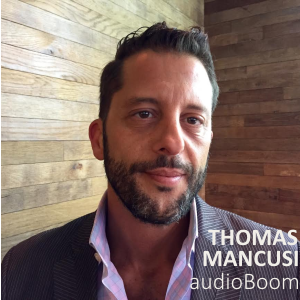This guest column is by Thomas Mancusi, Vice President, Sales and Development, audioBoom. Mancusi will be featured at the RAIN Online Audio Advertising Summit, Feb. 28 in New York, moderating the Podcast Advertising 360 panel. Some of the thoughts in this article were introduced in the RAIN Summit in June, 2016, at which Thomas Mancusi was a speaker. (Video here.)

For podcasting’s amazing advertising growth to increase in revenue and adoption by brand advertisers, the podcast industry needs to be speaking in one collective voice. Besides the lack of measurement unification and transparency with audience numbers, which gives new brands and agencies pause, I believe another issue is the industry terminology which differs among podcast networks and buying agencies.
What is a pre-roll? Is a live read actually read live? When does a live-read ad occur? Is mid-roll a live read or ad-injected spot? As the networks increase their technological offerings and capture the ability to send messaging via ad injectors, we need specific terms to differentiate the live reads from the pre-recorded spots. As agencies adopt this medium from just live reads to ad-injected spots — which can can be geo-targeted, day- and time-specific, limited to a certain amount of audio impressions — there needs to be clarity about on what is being sold and what is being purchased.
In my opinion, the only time pre-roll, mid-roll and post-roll should be mentioned is with pre-recorded ads that run through an ad injector for a set amount of impressions. These pre-recorded ads can be agency copy, producer read or host/talent read. Host/talent reads should be sold at a higher premium than the agency/producer copy that is created. These ads should be a maximum of 30 seconds in length — plus 15 seconds for branding could be acceptable as well. These are designated breaks before, during and after the content.
Live Reads or Talent Reads Within Content
These typically 60-second host read ads should be sold within content of the show and not in a set pre-roll/mid-roll or post-roll placement to avoid the very few who fast forward through such ads. These spots should be sold by slots in my opinion. For example a one-hour show should never have more than four live reads in it and three is better for a show of this length. I ask that shows place them in either Slot #1, Slot #2 or Slot #3.
- Slot #1 – after some content, but conducted before the 15% of content for that show (So before the 15 minute mark).
- Slot #2 – around the 35-45% of the content so before the traditional mid-roll placement or half way point of the show
- Slot #3 – would be before the 65% of the content is over
If a client purchases a campaign longer than three weeks their spots should receive fair and equal rotation — one in slot 1, one in slot 2 and one in slot 3.
If a brand or agency demands Slot #1 for all their ads or to never be in Slot #3, then a premium cost should be expected.
While we are at it, maybe it is time to put the term live read to bed, since no one is listening live unless the podcaster is in front of an audience at the time of production. Perhaps a better term is host read. So if it is a host-read ad, is it within the content — and if so, which slot will it be in? Or is it host-read, recorded, and injected in a set position such as pre-roll or mid-roll?
Put an end to the word download — it is a reminder of the archaic days of delivering a podcast. We know that people are now clicking on the play button and listening immediately at greater numbers (59% per Edison) than ever. At the same time, the amount of people downloading content (38% per Edison) is decreasing. How about using the word listens to describe the audience reach?
